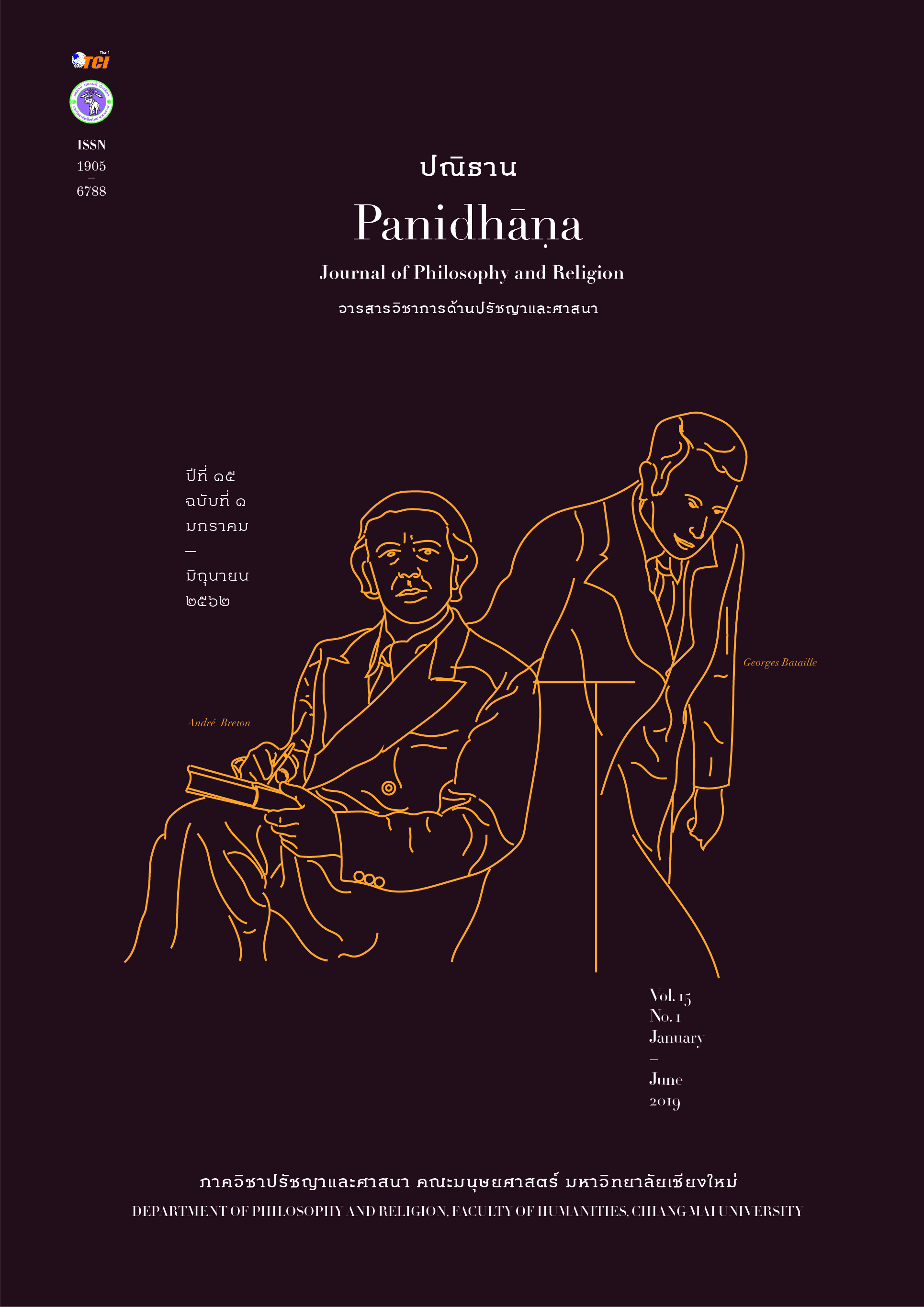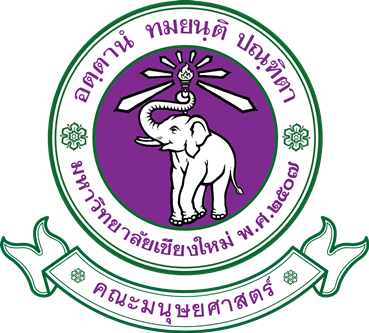การให้เหตุผลแบบจารนัยของนักเรียนระดับชั้นมัธยมศึกษา
กรณีศึกษาเกี่ยวกับปัญหาหมอกควันในภาคเหนือ
คำสำคัญ:
การให้เหตุผลแบบจารนัย, ปัญหาหมอกควัน, ปรัชญาวิทยาศาสตร์, วิทยาศาสตร์ศึกษา, สมมติฐานเชิงอธิบายบทคัดย่อ
การให้เหตุผลมีบทบาทสำคัญในกระบวนการสร้างความรู้ทางวิทยาศาสตร์ การให้เหตุผลทางวิทยาศาสตร์มีได้หลายประเภท เช่น การให้เหตุผลเชิงอุปนัย การให้เหตุผลเชิงนิรนัย และการให้เหตุผลแบบจารนัย การให้เหตุผลแบบจารนัยมักนำไปสู่การตั้งสมมติฐานเชิงอธิบาย ซึ่งทำหน้าที่เป็นกรอบแนวคิดทางทฤษฎีของการสืบเสาะทางวิทยาศาสตร์ แม้หลักสูตรวิทยาศาสตร์กำหนดเป้าหมายให้นักเรียนสร้างความรู้ผ่านการสืบเสาะทางวิทยาศาสตร์ ซึ่งการให้เหตุผลแบบจารนัยมีบทบาทสำคัญ แต่การวิจัยเกี่ยวกับการให้เหตุผลแบบจารนัยของนักเรียนยังไม่ปรากฏในวรรณกรรมด้านวิทยาศาสตร์ศึกษา กรณีศึกษานี้จึงมีวัตถุประสงค์เพื่อสำรวจว่า นักเรียนมีการให้เหตุผลแบบจารนัยอย่างไรในบริบทเกี่ยวกับปัญหาหมอกควันในภาคเหนืออย่างไร และนักเรียนใช้ความรู้เดิมอะไรในการให้เหตุผลแบบจารนัย ผู้วิจัยเก็บข้อมูลโดยการสัมภาษณ์แบบกึ่งโครงสร้างเป็นรายบุคลลกับนักเรียนชั้นมัธยมศึกษาปีที่ 1-6 ระดับชั้นละ 3 คน จำนวนรวม 18 คน และวิเคราะห์ข้อมูลด้วยวิธีการวิเคราะห์เนื้อหาเพื่อสร้างแก่นเรื่อง การวิจัยพบว่า นักเรียนใช้ความรู้เดิมของตนเองในการให้เหตุผลแบบจารนัย โดยประสบการณ์เชิงสถานที่มีบทบาทสำคัญ
เอกสารอ้างอิง
Baxter, L. M. & Kurtz, M. J. (2001). When a Hypothesis Is Not an Educated Guess. Science and Children, 38(7), 18-20.
Bureau of Academic Affairs and Educational Standard. (2010). tūa chī wat læ sāra kān rīanrū kǣn klāng klum sāra kān rīanrū witthayāsāt tām laksūt kǣn klāng kānsưksā naphư̄n thān Phutthasakkarāt 2551 [Indicators and Core Learning Content in Science According to the Basic Education Core Curriculum B.E. 2551]. Bangkok: Agricultural Co-operative Federation of Thailand.
Bureau of Academic Affairs and Educational Standard. (2017). tūa chī wat læ sāra kān rīanrū kǣn klāng klum sāra kān rīanrū witthayāsāt (chabap prapprung Phō̜.Sō̜. 2560) tām laksūt kǣn klāng kānsưksā naphư̄n thān Phutthasakkarāt 2551 [Indicators and Core Learning Content in Science (Revised Version of B.E. 2560) According to the Basic Education Core Curriculum B.E. 2551]. Bangkok: Agricultural Co-operative Federation of Thailand.
Dewey, J. (1910). How We Think. New York: D.C. HEATH & CO Publishers.
Galton, F. (1870). Experiments in Pangenesis, by Breeding from Rabbits of a Pure Variety, into Whose Circulation Blood Taken from Other Varieties Had Previously Been Largely Transfused. Proceedings of the Royal Society of London, 19, 393 – 410.
Giere, R. N. (1991). Understanding Scientific Reasoning. New York: Holt, Rinehart and Winston.
Glazer, N. (2011). Challenges with Graph Interpretation: A Review of the Literature. Studies in Science Education, 47(2), 183-210.
Guisasola, J., Ceberio, M., & Zubimendi, J. L. (2006). University Students’ Strategies for Constructing Hypothesis When Tackling Paper-and-Pencil Tasks in Physics. Research in Science Education, 36(3), 163-186.
Hempel, C. G. (1965). Aspects of Scientific Explanation and Other Essays in the Philosophy of Science. New York: The Free Press.
Johnston, J. S. (2009). What Does the Skill of Observation Look Like in Young Children?, International Journal of Science Education, 31(18), 2511- 2525.
Josephson, J. R. & Josephson, S. G. (1996). Abductive Inference: Computation, Philosophy, Technology. New York: Cambridge University Press.
Kim, H. J. & Pedersen, S. (2011). Advancing Young Adolescents’ Hypothesis-Development Performance in a Computer-Supported and Problem-Based Learning Environment. Computer and Education, 57(2), 1780-1789.
Kreasuwun, J., Chodamornsuk, C., Wirunvedchayan, O., & Ratjiranukool, P. (2008). kān čhamlō̜ng kān plīanplǣng saphāp phūmiʻākāt samrap prathēt Thai dūai bǣpčhamlō̜ng phūmiʻākāt MM5 [Weather Analysis and Air Pollution Warning: Full Research Report (Project Code RDG5130002)]. Bangkok: The Thailand Research Fund.
Kwon, Y., Jeong, J., & Park, Y. (2006). Roles of Abductive Reasoning and Prior Belief in Children’s Generation of Hypotheses about Pendulum Motion. Science and Education, 15(6), 643-656.
Ladachart, L. (2018). kān rīan kānsō̜n witthayāsāt thī pen witthayāsāt : prawattisāt pratyā læ kānsưksā [Teaching and Learning Science Scientifically: History, Philosophy, and Education]. Bangkok: Chulalongkorn University Press.
Ladachart, L. Chimphali, K., Aryowong, N., Ngaewkoodrua, N., Srakhoa, S., Wangead, C., & Thammaprateep, J. (2015). kān long khō̜ sarup læ sāng khamʻathibāi thāng witthayāsāt khō̜ng nakrīan chan matthayommasưksā pī thī sām [Ninth Grade Students’ Making Scientific Inferencesand Explanations]. Silpakorn University Journal of Social Sciences, Humanities and Art in Thai Language, 35(1), 171-206.
Ladachart, L. & Ladachart, L. (2016). kān tang kham thām kīeokap witthayāsāt khō̜ng nakrīan chan prathomsưksā pī thī hā [Fifth Grade Students’ Questioning about Science]. Journal of Humanities and Social Sciences, Mahasarakham University, 35(1), 188-202.
——————. (2017). čhāk kān sư̄pso̜ tām wattačhak hā Es sū kān sư̄pso̜ thī mī thritsadī chīnam [From 5Es Inquiry Cycle towards Theory-Directed Inquiry]. Journal of Research Unit on Science, Technology and Environment for Learning, 8(2), 436-448.
——————. (in press). wādūai thammachāt khō̜ng sommotithān thāng witthayāsāt læ kānnam pai chai naikānčhatkān rīan kānsō̜n [ON Nature of Scientific Hypotheses and Its Implications for Science Teaching and Learning]. Journal of Education, Naresuan University.
Lawson, A. E. (1995). Science Teaching and the Development of Thinking. California: Wadsworth Publishing Company.
Lincoln, Y. S. & Guba, E. G. (1985). Naturalistic Inquiry. California: Sage Publications.
Mcauliffe, W. H. B. (2015). How Did Abduction Get Confused with Inference to the Best Explanation?. Transactions of the Charles S. Peirce Society, 51(3), 300-319.
McComas, W. F. (1998). The Principal Elements of the Nature of Science: Dispelling the Myths. In W. F. McComas (Ed.). The Nature of Science in Science Education: Rationales and Strategies. (pp. 53-70). The Netherlands: Kluwer Academic Publishers.
NGSS Lead States. (2013). Next Generation Science Standards: For States, By States. Washington D.C.: National Academy of Sciences.
Nersessian, N. J. (2008). Creating Scientific Concepts. London: A Bradford Book, The MIT Press.
Oh, P. S. (2010). How Can Teachers Help Students Formulate Scientific Hypotheses? Some Strategies Found in Abductive Inquiry Activities of Earth Science. International Journal of Science Education, 32(4), 541-560.
Okasha, S. (2002). pratyā witthayāsāt dōisangkhēp [Philosophy of Science: A Very Short Introduction]. Bangkok: The Princess Maha Chakri Sirindhorn Anthropology Centre. (Translation into Thai by Chanthamrong, C. in 2006).
Park, J. (2006). Modelling Analysis of Students’ Processes of Generating Scientific Explanatory Hypotheses. International Journal of Science Education, 28(5), 469-489.
Patton, M. Q. (2002). Qualitative Research and Evaluation Methods. (3rd Edition). California: Sage Publication.
Pochanaet, P. (2016). sathānakān khō̜ng panhā monlaphit thāng ʻākāt thī kœ̄t nai mư̄ang yai khō̜ng prathēt Thai : kō̜ranī sưksā Krung Thēp Mahā Nakhō̜n Chīang Mai læ ra yō̜ng [The Present State of Urban Air Pollution Problems in Thailand’s Large Cities: Cases of Bangkok, Chiang Mai, and Rayong]. Journal of Environmental Management, 12(1), 114-133.
Pongsophon, P. (2009). sō̜n witthayāsāt yāng thī witthayāsāt pen [Teach Science as Science Is]. Science Journal, 63(1), 84 – 89.
Rayanakorn, M. (2010). mō̜k khwan læ monlaphit thāng ʻākāt nai čhangwat Chīang Mai [Haze and Air Pollution in Chiang Mai]. Chiang Mai: Login Design Work.
Songer, N. B. & Gotwals, A. W. (2012). Guiding Explanation Construction by Children at the Entry Point of Learning Progressions. Journal of Research in Science Teaching, 49(2), 141-165.
Supasorn, S. (2011). krabūankān sư̄pso̜ thāng witthayāsāt nai kān thotlō̜ng khēmīradap matthayommasưksā tō̜n plāi : kān thopthūan ngānwičhai dān witthayāsāt sưksā čhāk mahāwitthayālai ʻUbon rātchathānī [Science Inquiry Process in High School Chemistry Experiments: A Review of Science Education Research Studies from Ubon Ratchathani University]. Journal of Education, Prince of Songkla University, Pattani Campus, 22(3), 331 – 343.
Suttakun, L. & Ladachart, L. (2013). kānhai hētphon thāng witthayāsāt khō̜ng nakrīan chan prathomsưksā pī thī 4 [Fourth Grade Students’ Scientific Reasoning]. Naresuan University Journal: Science and Technology, 21(3), 107-123.
Thagard, P. (1992). Conceptual Revolutions. New Jersey: Princeton University Press.
Walton, D. N. (2001). Abductive, Presumptive and Plausible Arguments. Informal Logic, 21(2), 141-169.
Yin, R. K. 2014. Case Study Research: Design and Methods (5th Edition). California: SAGE Publications.
Zangori, L. & Forbes, C. T. (2014). Scientific Practices in Elementary Classrooms: third-Grade Students’ Scientific Explanations for Seed Structure and Function. Science Education, 98(4), 614-639.
Websites:
Bybee, R. W., Taylor, J. A., Gardner, A., Scotter, P. V., Powell, J. C., Wesbrook, A., & Landes, N. (2006). The BSCS 5E Instructional Models: Origins, Effectiveness, and Applications. Retrieved from: https://www.bscs.org/sites/default/files/_legacy/BSCS_5E_Instructional_Model-Executive_Summary_0.pdf
Classical Wisdom. (2018). Metaphysics by Aristotle – Book I. Retrieved from: https://classicalwisdom.com/greek_books/metaphysics-by-aristo-tle-book-i/
Office of Agricultural Economics. (2018). patithin phonphalit sētthakit thī samkhan rāi dư̄an [Monthly Calendar of Important Agricultural Products].Retrieved from: https://www.oae.go.th/assets/portals/1/files/ebook/calen-dar.pdf
Pollution Control Department. (2018). rāingān sathānakān læ khunnaphāp ʻākāt prathēt Thai [Reports on Situations and Air Quality in Thailand]. Re-trieved from: https://air4thai.pcd.go.th/webV2/download.php
Thai Meteorological Department. (n.d.). khwāmrū ʻutuniyomwitthayā [Meteorological Knowledge]. Retrieved from: https://www.tmd.go.th/info/info.php?FileID=23
ไฟล์ประกอบ
เผยแพร่แล้ว
รูปแบบการอ้างอิง
ฉบับ
ประเภทบทความ
สัญญาอนุญาต
เนื้อหาของบทความที่ได้รับการตีพิมพ์ในวารสารปณิธานถือเป็นลิขสิทธิ์ของวารสารปณิธาน ห้ามเผยแพร่ ตัดต่อ แก้ไข หรือนำไปใช้ก่อนได้รับอนุญาต
ผู้สนใจสามารถติดต่อขอเผยแพร่เนื้อหาในวารสารปณิธานได้ที่ panidhana-human@cmu.ac.th







